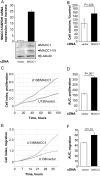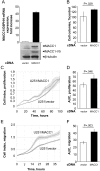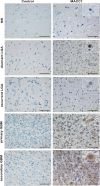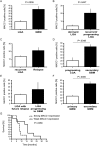Impact of MACC1 on human malignant glioma progression and patients' unfavorable prognosis
- PMID: 24220141
- PMCID: PMC3829600
- DOI: 10.1093/neuonc/not136
Impact of MACC1 on human malignant glioma progression and patients' unfavorable prognosis
Abstract
Background: Metastasis-associated in colon cancer 1 (MACC1) has been established as an independent prognostic indicator of metastasis formation and metastasis-free survival for patients with colon cancer and other solid tumors. However, no data are available concerning MACC1 expression in human astrocytic tumors. Glioblastoma multiforme (GBM) is the most prevalent primary brain tumor of adulthood, and due to its invasive and rapid growth, patients have unfavorable prognoses. Although these tumors rarely metastasize, their invasive and migratory behavior is similar to those of metastatic cells of tumors of different origin. Thus, we hypothesized that MACC1 may be involved in progression of human gliomas.
Methods: We performed real-time measurements of proliferation and migration in MACC1-transfected GBM cell lines (U138, U251) and evaluated tumor formation in organotypic hippocampal slice cultures of mice. Semiquantitative and quantitative real-time reverse transcription PCR analyses were performed for MACC1 and for its transcriptional target c-Met in human astrocytoma of World Health Organization grade II (low-grade astrocytoma) and GBM biopsies. Data were validated by MACC1 immunohistochemistry in independent matched samples of low-grade astrocytoma and GBM.
Results: MACC1 increases the proliferative, migratory, and tumor-formation abilities of GBM cells. The c-Met inhibitor crizotinib reduced MACC1-induced migration and tumor formation in organotypic hippocampal slice cultures of mice. Analyzing patients' biopsies, MACC1 expression increased concomitantly with increasing World Health Organization grade. Moreover, MACC1 expression levels allowed discrimination of dormant and recurrent low-grade astrocytomas and of primary and secondary GBM. Strong MACC1 expression correlated with reduced patient survival.
Conclusions: MACC1 may represent a promising biomarker for prognostication and a new target for treatment of human gliomas.
Keywords: MACC1; astrocytoma WHO grade II; glioblastoma multiforme; prognostication; progression.
Figures







Similar articles
-
MiRNA expression profiling in human gliomas: upregulated miR-363 increases cell survival and proliferation.Tumour Biol. 2016 Oct;37(10):14035-14048. doi: 10.1007/s13277-016-5273-x. Epub 2016 Aug 6. Tumour Biol. 2016. PMID: 27495233
-
MicroRNA-584-3p, a novel tumor suppressor and prognostic marker, reduces the migration and invasion of human glioma cells by targeting hypoxia-induced ROCK1.Oncotarget. 2016 Jan 26;7(4):4785-805. doi: 10.18632/oncotarget.6735. Oncotarget. 2016. PMID: 26715733 Free PMC article.
-
Metastasis-Associated in Colon Cancer-1 Associates With Poor Prognosis and Promotes Cell Invasion and Angiogenesis in Human Cervical Cancer.Int J Gynecol Cancer. 2015 Oct;25(8):1353-63. doi: 10.1097/IGC.0000000000000524. Int J Gynecol Cancer. 2015. PMID: 26332389 Free PMC article.
-
Intracranial high-grade glioma with malignant progression of spinal intramedullary metastasis: an atypical presentation with review of literature.Br J Neurosurg. 2023 Dec;37(6):1495-1501. doi: 10.1080/02688697.2021.1961682. Epub 2021 Aug 16. Br J Neurosurg. 2023. PMID: 34396889 Review.
-
Expression of estrogen and progesterone receptors in astrocytomas: a literature review.Clinics (Sao Paulo). 2016 Aug;71(8):481-6. doi: 10.6061/clinics/2016(08)12. Clinics (Sao Paulo). 2016. PMID: 27626480 Free PMC article. Review.
Cited by
-
Genomic Profiling of Thyroid Cancer Reveals a Role for Thyroglobulin in Metastasis.Am J Hum Genet. 2016 Jun 2;98(6):1170-1180. doi: 10.1016/j.ajhg.2016.04.014. Epub 2016 May 26. Am J Hum Genet. 2016. PMID: 27236916 Free PMC article.
-
Silence of MACC1 expression by RNA interference inhibits proliferation, invasion and metastasis, and promotes apoptosis in U251 human malignant glioma cells.Mol Med Rep. 2015 Sep;12(3):3423-3431. doi: 10.3892/mmr.2015.3886. Epub 2015 Jun 3. Mol Med Rep. 2015. PMID: 26043756 Free PMC article.
-
MACC1-Induced Collective Migration Is Promoted by Proliferation Rather Than Single Cell Biomechanics.Cancers (Basel). 2022 Jun 9;14(12):2857. doi: 10.3390/cancers14122857. Cancers (Basel). 2022. PMID: 35740524 Free PMC article.
-
Prognostic and Risk Stratification Value of Lesion MACC1 Expression in Colorectal Cancer Patients.Front Oncol. 2019 Feb 5;9:28. doi: 10.3389/fonc.2019.00028. eCollection 2019. Front Oncol. 2019. PMID: 30805302 Free PMC article.
-
Metastasis Associated in Colorectal Cancer 1 (MACC1) mRNA Expression Is Enhanced in Sporadic Vestibular Schwannoma and Correlates to Deafness.Cancers (Basel). 2023 Aug 14;15(16):4089. doi: 10.3390/cancers15164089. Cancers (Basel). 2023. PMID: 37627117 Free PMC article.
References
-
- Hannahan D, Weinberg RA. Hallmarks of cancer: the next generation. Cell. 2011;144:646–674. - PubMed
-
- Stein U, Walther W, Arlt F, et al. MACC1, a newly identified key regulator of HGF-MET signaling, predicts colon cancer metastasis. Nat Med. 2009;15:59–67. - PubMed
-
- Arlt F, Stein U. Colon cancer metastasis: MACC1 and Met as metastatic pacemakers. Int J Biochem Cell Biol. 2009;41:2356–2359. - PubMed
-
- Pichorner A, Sack U, Kobelt D, et al. In vivo imaging of colorectal cancer growth and metastasis by targeting MACC1 with shRNA in xenografted mice. Clin Exp Metastasis. 2012;29:573–583. - PubMed
MeSH terms
Substances
LinkOut - more resources
Full Text Sources
Other Literature Sources
Medical
Miscellaneous

